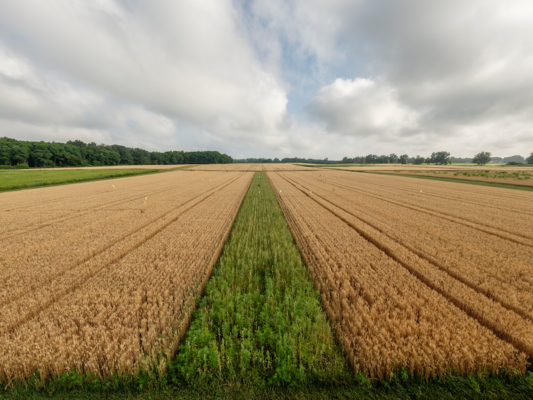
A prairie strip growing in wheat at the KBS LTER Main Cropping Systems Experiment.
Credit: Kurt Stepnitz
In agricultural landscapes, predatory insects provide an essential ecosystem service — valued at billions of dollars annually — by suppressing pests that damage crops. A new study that includes data from Kellogg Biological Station LTER (KBS LTER) found that natural pest suppression gains a big boost when agricultural landscapes are patchy and include a high ratio of natural ‘edge habitat’ between fields.
Better understanding how pest suppression works can help researchers and growers to maintain productive crop yields. Past studies have focused on the types of habitat patches surrounding crop fields, but sometimes this doesn’t tell the whole story and the relationship is not always consistent. This study, which draws on KBS LTER data together with data from Southern Wisconsin, focuses instead on the spatial arrangement of habitat patches.
The group found that pest suppression at Michigan sites was consistently higher in landscapes with smaller, more interlaced patches — either of agricultural and non-agricultural habitats or of different crops. Crop production at the Michigan sites benefited from a high edge contrast between annual crops and surrounding habitat. Grasslands appeared to be particularly beneficial as habitats for natural pest enemies and may be most effective when they are directly adjacent to annual crops.
The type of configuration that provides optimal pest suppression varied depending on the crop or geographic region in question. At the Wisconsin sites, pest suppression increased in conjunction with large core areas of grasslands and smaller fields, which increased within-field biodiversity along with pest suppression. Large grassland patches may provide better habitat for species that favor core habitat, which then spill over into nearby habitat patches. The major differences in optimal landscape configurations between these sites and those in Michigan could be due to the distinct physical geographies, farming practices, and landscape structures involved.
Dr. Yajun Zhang of Michigan State University said, “This result suggests promising opportunities to increase pest suppression via precision conservation in agricultural landscapes. Converting low yielding portions of annual crop fields to perennial grasslands would efficiently enhance configurational complexity in agricultural landscapes, reduce input costs, and benefit pest suppression services.”
The team concluded that — in many cases — the benefit of increased pest suppression leading to increased yields would make it worthwhile to reconfigure landscapes. By helping maximize biodiversity and ecosystem services, such research studies offer a win-win for both nature and economy.
Sidney Gerst
Yajun Zhang, Nathan L. Haan, Douglas A. Landis. 2020. Landscape composition and configuration have scale-dependent effects on agricultural pest suppression, Agriculture, Ecosystems & Environment. Volume 302. https://doi.org/10.1016/j.agee.2020.107085.










